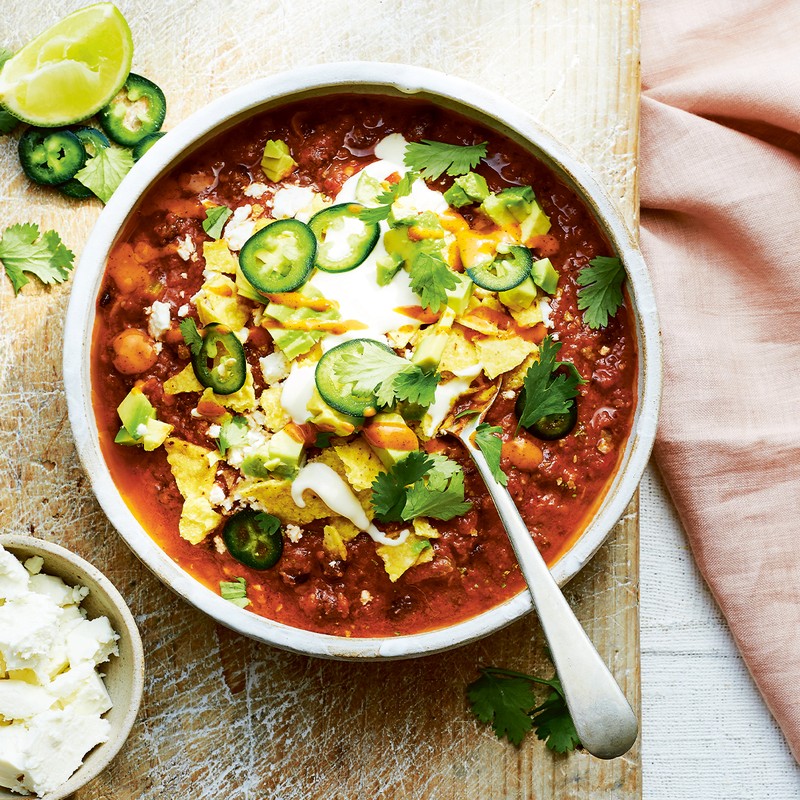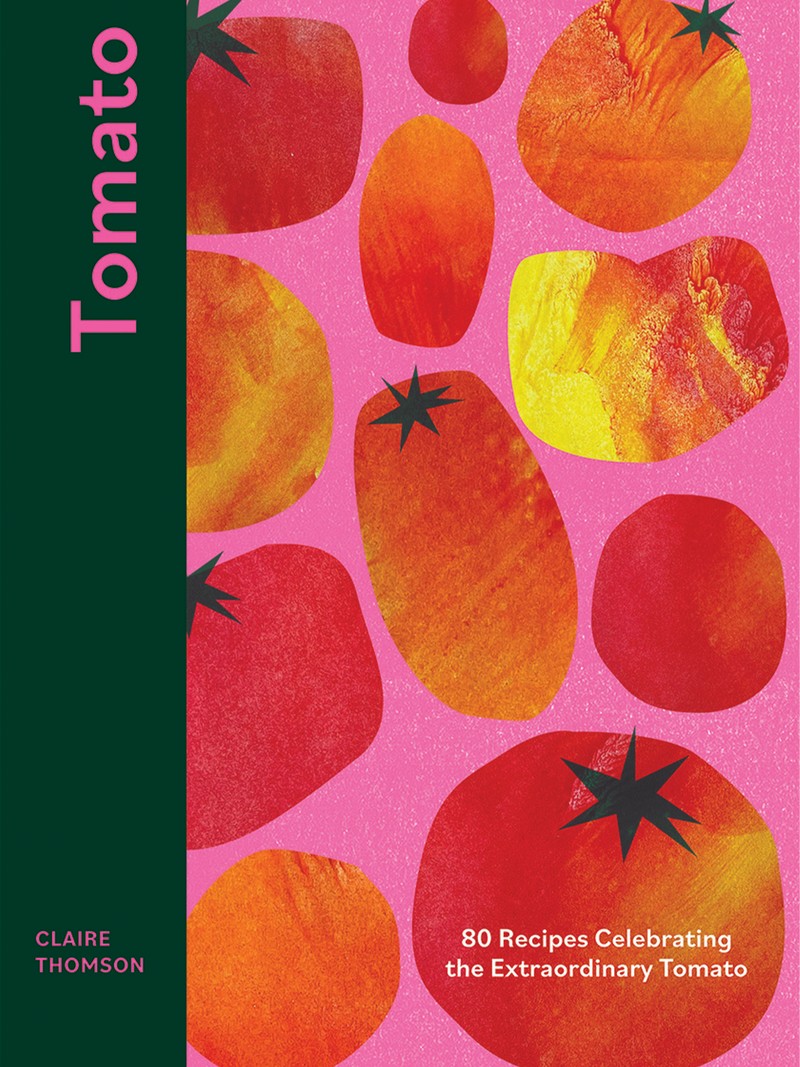How To Cook With Tomatoes
My book was always going to focus on both fresh tomatoes and processed tomatoes. Despite being a summer fruit, their culinary use straddles the seasons, proving they’re a vital, year-round ingredient. Processed tomatoes, by which I mean canned, bottled or puréed, are not inferior to fresh, and I would encourage anyone to use the best-quality processed tomatoes they can.
Look for plum tomatoes – San Marzano, in particular. I also like to use canned cherry tomatoes. The contents of every can – plum or cherry – are made up of two separate ingredients: the tomatoes themselves (usually four or five plum tomatoes, if that’s what you’re using) and the juice. You can use the entire contents of a can, or, if you want to use canned tomatoes like you would fresh (perhaps in a cooked dish), you can pop them in to cook without the juice – but do save the juice for a later date. Processed tomatoes have already been cooked just a little to preserve them, which means they taste more intense than their fresh equivalents.
Think of tomato purée as concentrated tomato. The good stuff should taste great, just as it is, squeezed straight from the tube… like tomatoes left to dry in the sun for maximum flavour. I’m duty bound to encourage you to steer clear of freighted, out-of-season fruit – all you need to do is to switch from fresh to preserved and back again, as the seasons dictate.
Tomatoes are one of a handful of ingredients that envelop four of the five flavour profiles – sweet, sour, bitter and umami. The fifth is salt, which we all know tomatoes carry beautifully. Crucially, cooked in dishes, tomatoes provide body, enriching a sauce as it bubbles, the tomatoes breaking down and thickening to give viscosity. If you blend a tomato sauce that has been cooked in oil or butter, for example, you will end up with something deeply creamy and velvety.
Tomatoes are one of my top three ingredients. The other two are olive oil and lemons – I could not be without them. I will stand by the fact that my favourite kitchen task of all time is to make a nick on the skin of a perfectly ripe, but still firm, fresh tomato, then plunge it into rolling, boiling water for 10 seconds. Then, I immediately transfer the tomato to a bowl of iced water, leaving it for 10 seconds, only for the skin to slip easily away like thickly waxed paper. What emerges is a flesh that is smooth, pink-tinged and almost iridescent.
Inspired? Here Are Four Of Claire’s Favourite Recipes…
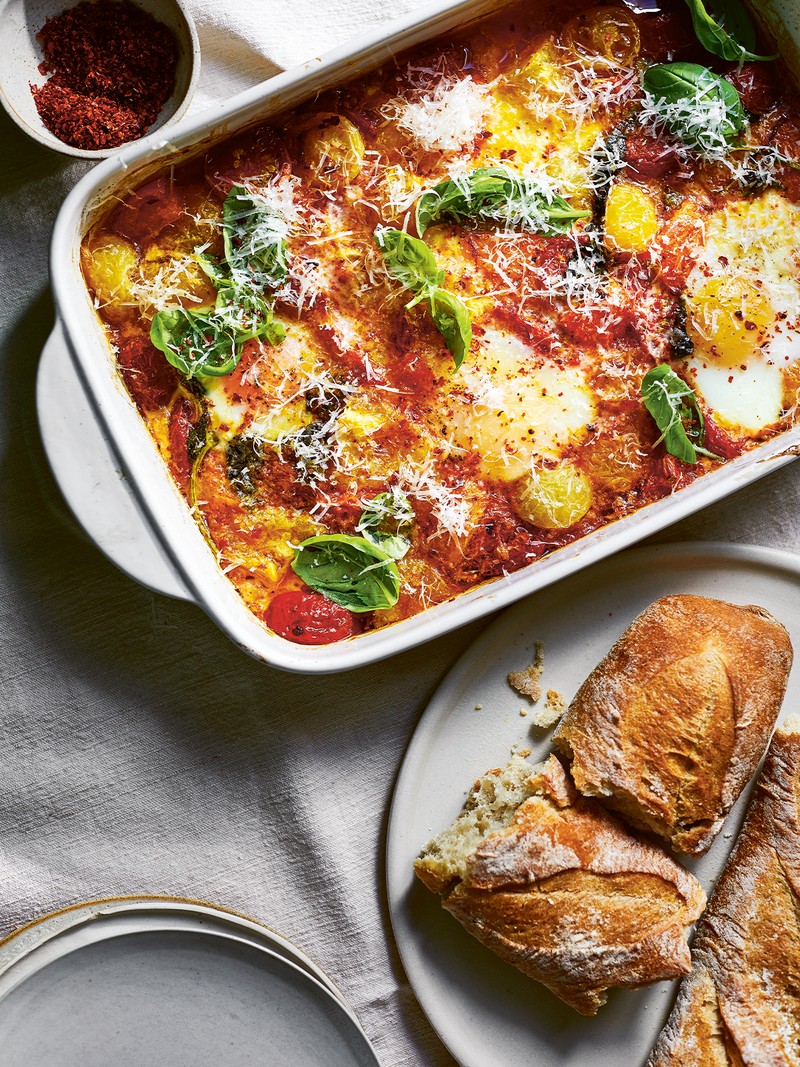
Baked Tomatoes & Eggs With Basil, Chilli & Parmesan
This is exactly the sort of breakfast or brunch I would like to eat after a very late night and too much to drink. It’s effortless to pull together, looks inviting and demands to be eaten. Best of all, it calls for great hunks of bread, blasting through the barely set egg yolks and tomato juices. This dish makes having a hangover worth it – well, nearly
Pre-heat the oven to 190°C/170°C Fan/Gas Mark 5.
Arrange the tomatoes in a baking dish of about 20cm x 30cm. Tuck the garlic in among the tomatoes, add three-quarters of the basil, then the olive oil and boiling water. Season well with salt and pepper.
Bake the tomatoes, uncovered, for about 20 minutes, until they have softened, slumping into a sauce of sorts.
Remove the dish from the oven and tease four pockets into the surface area of the tomatoes (using the back of a spoon), cracking an egg into each. Season the eggs and turn up the heat to 220°C/200°C Fan/Gas 7.
Cover and return the dish to the oven and bake for about 8-10 minutes, until the egg whites are opaque but the yolks are still runny.
Remove the dish from the oven, scatter over the remaining basil and the chilli flakes and parmesan. Drizzle with a little extra olive oil, if you like, and serve with good bread.

Fried Potato Cakes With Tomato & Parmesan
You will need floury potatoes for this recipe to turn into meltingly soft potato cakes topped with peeled, thinly sliced tomatoes, a good amount of herbs and some parmesan. It’s the contrast between crisp, soft fried potato and the raw peeled tomato on top that’s so appealing.
Pre-heat the oven to 180°C/160°C Fan/Gas Mark 4.
Pierce the potatoes several times with the tip of a sharp knife and bake on a baking sheet for 45 minutes to an hour, or until fluffy and tender.
While the potatoes are baking, bring a large pan of water to a boil. Slash the skin of each tomato with a sharp knife and plunge the tomatoes into the boiling water for 10 seconds. Remove with a slotted spoon, then place the tomatoes under cold running water or into a bowl of iced water for 30 seconds to arrest any further cooking. Remove from the cold water and then the skins should slip off easily. Thinly slice the peeled tomatoes, draining them on a plate, and put to one side.
When the potatoes are cooked through, cut them in half and scoop the flesh into a bowl. Use a ricer or potato masher and process until smooth. Season well with salt and pepper and, while the potato is still warm, beat in the egg yolks and butter. Scatter the flour over the mixture and mix briefly to combine.
Divide the mixture into 4 equal portions and shape each into a disk.
Heat a frying pan over a moderate heat and add a splash of oil. Carefully place the potato cakes in the hot oil and fry for 3-4 minutes, until golden brown on the underside. You may need to work in batches – don’t overcrowd the pan. Flip the potato cakes over and fry until golden brown on the other side and piping hot throughout.
Arrange the potato cakes on a serving plate and top with a good amount of the thinly sliced tomatoes. Radicchio or treviso or any bitter leaf is nice here, the herbs and parmesan complement the tomatoes too. Add a splash of good olive oil to serve.
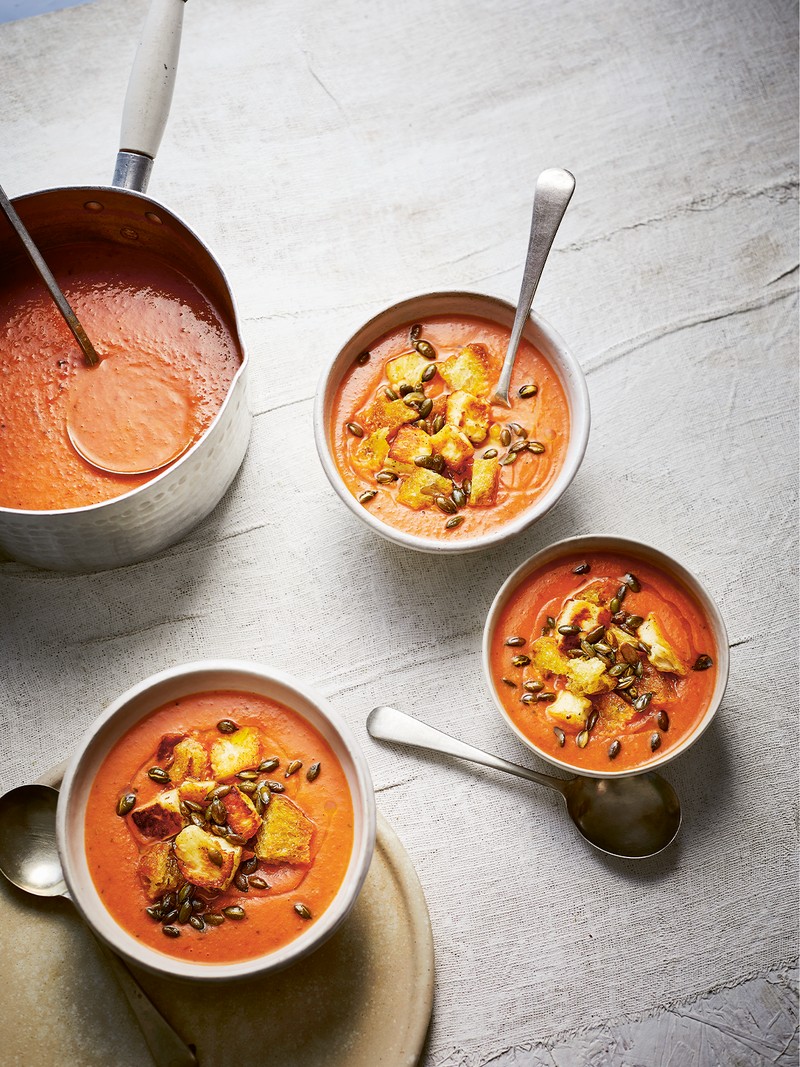
Roasted Tomato, Fennel & Potato Soup With Fried Sourdough, Pumpkin Seeds & Halloumi
Blended super-smooth, the tomatoes in this soup are impossibly rich and glossy, blitzed as they are with the fennel and potato. Roasting the tomatoes intensifies their flavour. Fennel is part of the parsley family and shares that same anise-type characteristic, which pairs so beautifully with tomato. As for the scattergun of toppings, these are by no means set in stone. I’m just suggesting this combination. Switch to feta if you prefer, or leave out dairy entirely; likewise the croûtons, and use whichever seeds or nuts you have to hand.
Pre-heat the oven to 200°C/180°C Fan/Gas Mark 6. Spread the tomatoes, cut side up, and the potato slices on a baking sheet lined with baking paper. Add the onion, ground fennel and garlic. Add two-thirds of the thyme leaves and drizzle with half the olive oil. Roast for 25-30 minutes, until the veg is tender, the garlic soft, and the tomatoes have just begun to caramelize. Leave to cool for 5 minutes.
Meanwhile, put the pieces of bread on a separate baking sheet and drizzle with 1 tablespoon of the remaining olive oil. Roast for about 10 minutes, turning the bread midway through the cooking time, until golden brown and crunchy. Remove the croûtons from the oven and set to one side.
When the roasted vegetables are cool enough to process, blend them with their cooking juices in a food processor or blender until creamy and smooth. Place the soup in a saucepan over a low heat, add the stock to your preferred thickness, then stir and add salt and pepper to taste. Bring to a gentle simmer, then remove from the heat.
While the soup is heating up, add another tablespoon of the remaining olive oil and the pumpkin seeds to a frying pan over a moderate heat and fry the seeds for about 3 minutes, until they pop and sizzle. Remove from the heat and put to one side.
Wipe out the pan and add the remaining tablespoon of olive oil. Place the pan back over a moderate heat and fry the halloumi for about 2 minutes, turning frequently, until the cubes are golden all over. Add the remaining thyme leaves, along with the fried pumpkin seeds, chilli flakes and croûtons. Put to one side in a serving bowl.
Top the soup with the croûton mixture and serve with an extra slick of olive oil.
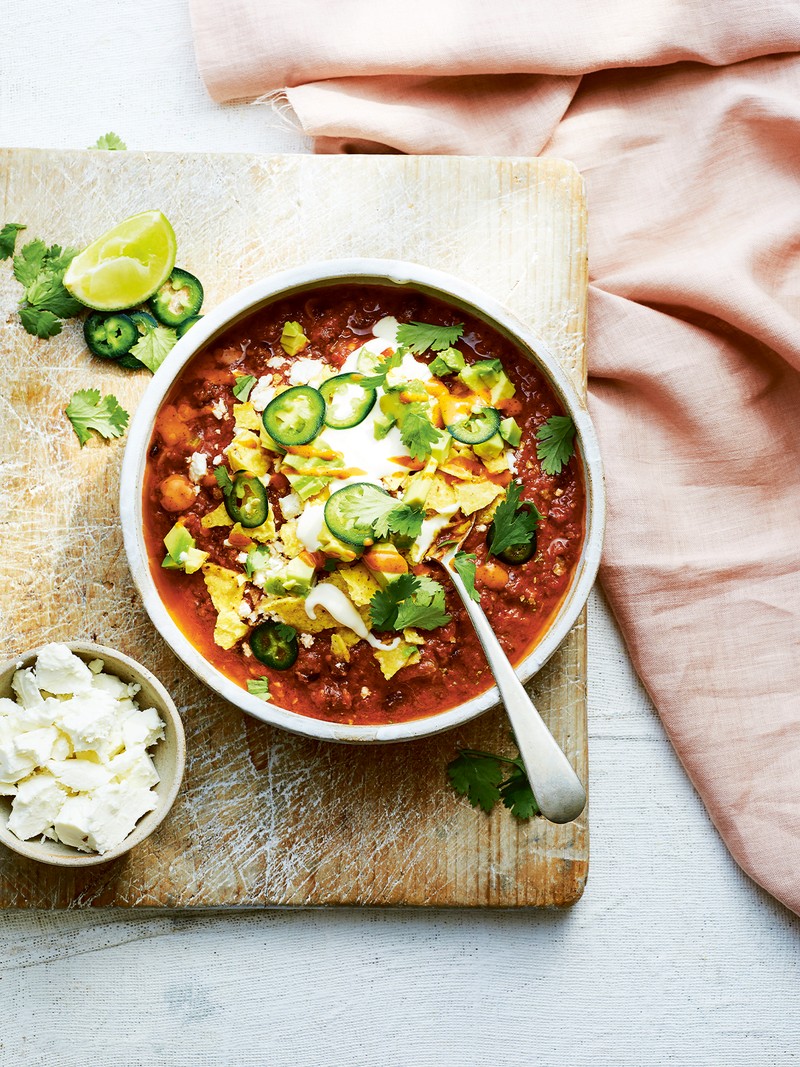
Tomato, Chipotle Chilli & Oregano Soup With Feta & Black Beans
If you have the time and inclination, it’s worth soaking and cooking your own black beans for this recipe. However, you can make it just as well with a can of black beans and some stock. Adding tomatoes to this bean soup brings out a velvety, fruity acidity in the creamy black beans. My serving suggestion is quite lengthy, but absolutely worth it. The soup would go especially well with a dollop of hot sauce to serve.
Heat the oil in a saucepan over a moderate heat. Add the onions, celery and salt and cook for about 10-12 minutes, until the onions are soft and just beginning to brown. Add the garlic and cook for 2 minutes more, to soften.
Add the chipotles (plus any liquid), the tomato purée, tomatoes and bay leaves and cook for 10-15 minutes, until rich and thick.
Add the beans and stock and bring the liquid to a boil. You can add a splash more stock if you think it needs it, depending on how thick you’d like the soup to be when you come to serve it. Check the seasoning, adding salt and pepper, as necessary.
Remove the soup from the heat. I like to partially blend the soup at this point – about one third blended is ideal. Remove the bay leaves, then use a stick blender in the pan or remove a portion and blend that before adding it back to the pan.
Serve the warm soup in bowls and top each bowl with chopped avocado, sour cream, feta, coriander, corn chips and chillies, and with hot sauce and lime wedges for helping yourselves.
Tomato by Claire Thomson (Quadrille, £22)
Photography: Sam Folan.
Visit Waterstones.com
DISCLAIMER: We endeavour to always credit the correct original source of every image we use. If you think a credit may be incorrect, please contact us at info@sheerluxe.com.
